Input interpretation

SO_2 sulfur dioxide + PbO_2 lead dioxide ⟶ PbSO_4 lead(II) sulfate
Balanced equation
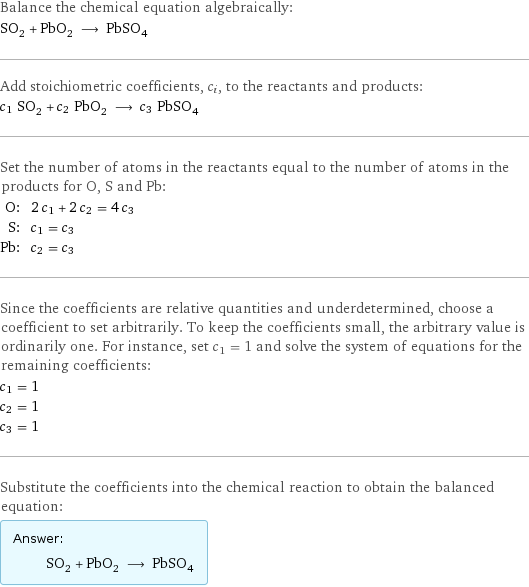
Balance the chemical equation algebraically: SO_2 + PbO_2 ⟶ PbSO_4 Add stoichiometric coefficients, c_i, to the reactants and products: c_1 SO_2 + c_2 PbO_2 ⟶ c_3 PbSO_4 Set the number of atoms in the reactants equal to the number of atoms in the products for O, S and Pb: O: | 2 c_1 + 2 c_2 = 4 c_3 S: | c_1 = c_3 Pb: | c_2 = c_3 Since the coefficients are relative quantities and underdetermined, choose a coefficient to set arbitrarily. To keep the coefficients small, the arbitrary value is ordinarily one. For instance, set c_1 = 1 and solve the system of equations for the remaining coefficients: c_1 = 1 c_2 = 1 c_3 = 1 Substitute the coefficients into the chemical reaction to obtain the balanced equation: Answer: | | SO_2 + PbO_2 ⟶ PbSO_4
Structures

+ ⟶
Names

sulfur dioxide + lead dioxide ⟶ lead(II) sulfate
Reaction thermodynamics
Enthalpy

| sulfur dioxide | lead dioxide | lead(II) sulfate molecular enthalpy | -296.8 kJ/mol | -277.4 kJ/mol | -920 kJ/mol total enthalpy | -296.8 kJ/mol | -277.4 kJ/mol | -920 kJ/mol | H_initial = -574.2 kJ/mol | | H_final = -920 kJ/mol ΔH_rxn^0 | -920 kJ/mol - -574.2 kJ/mol = -345.8 kJ/mol (exothermic) | |
Gibbs free energy
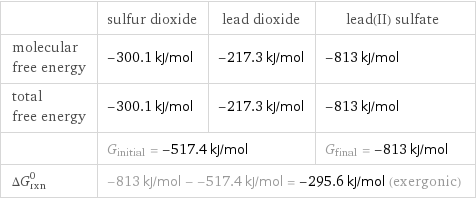
| sulfur dioxide | lead dioxide | lead(II) sulfate molecular free energy | -300.1 kJ/mol | -217.3 kJ/mol | -813 kJ/mol total free energy | -300.1 kJ/mol | -217.3 kJ/mol | -813 kJ/mol | G_initial = -517.4 kJ/mol | | G_final = -813 kJ/mol ΔG_rxn^0 | -813 kJ/mol - -517.4 kJ/mol = -295.6 kJ/mol (exergonic) | |
Entropy

| sulfur dioxide | lead dioxide | lead(II) sulfate molecular entropy | 248 J/(mol K) | 69 J/(mol K) | 149 J/(mol K) total entropy | 248 J/(mol K) | 69 J/(mol K) | 149 J/(mol K) | S_initial = 317 J/(mol K) | | S_final = 149 J/(mol K) ΔS_rxn^0 | 149 J/(mol K) - 317 J/(mol K) = -168 J/(mol K) (exoentropic) | |
Equilibrium constant
![Construct the equilibrium constant, K, expression for: SO_2 + PbO_2 ⟶ PbSO_4 Plan: • Balance the chemical equation. • Determine the stoichiometric numbers. • Assemble the activity expression for each chemical species. • Use the activity expressions to build the equilibrium constant expression. Write the balanced chemical equation: SO_2 + PbO_2 ⟶ PbSO_4 Assign stoichiometric numbers, ν_i, using the stoichiometric coefficients, c_i, from the balanced chemical equation in the following manner: ν_i = -c_i for reactants and ν_i = c_i for products: chemical species | c_i | ν_i SO_2 | 1 | -1 PbO_2 | 1 | -1 PbSO_4 | 1 | 1 Assemble the activity expressions accounting for the state of matter and ν_i: chemical species | c_i | ν_i | activity expression SO_2 | 1 | -1 | ([SO2])^(-1) PbO_2 | 1 | -1 | ([PbO2])^(-1) PbSO_4 | 1 | 1 | [PbSO4] The equilibrium constant symbol in the concentration basis is: K_c Mulitply the activity expressions to arrive at the K_c expression: Answer: | | K_c = ([SO2])^(-1) ([PbO2])^(-1) [PbSO4] = ([PbSO4])/([SO2] [PbO2])](../image_source/e7215a95e77cb7a4e003c49df7c4766c.png)
Construct the equilibrium constant, K, expression for: SO_2 + PbO_2 ⟶ PbSO_4 Plan: • Balance the chemical equation. • Determine the stoichiometric numbers. • Assemble the activity expression for each chemical species. • Use the activity expressions to build the equilibrium constant expression. Write the balanced chemical equation: SO_2 + PbO_2 ⟶ PbSO_4 Assign stoichiometric numbers, ν_i, using the stoichiometric coefficients, c_i, from the balanced chemical equation in the following manner: ν_i = -c_i for reactants and ν_i = c_i for products: chemical species | c_i | ν_i SO_2 | 1 | -1 PbO_2 | 1 | -1 PbSO_4 | 1 | 1 Assemble the activity expressions accounting for the state of matter and ν_i: chemical species | c_i | ν_i | activity expression SO_2 | 1 | -1 | ([SO2])^(-1) PbO_2 | 1 | -1 | ([PbO2])^(-1) PbSO_4 | 1 | 1 | [PbSO4] The equilibrium constant symbol in the concentration basis is: K_c Mulitply the activity expressions to arrive at the K_c expression: Answer: | | K_c = ([SO2])^(-1) ([PbO2])^(-1) [PbSO4] = ([PbSO4])/([SO2] [PbO2])
Rate of reaction
![Construct the rate of reaction expression for: SO_2 + PbO_2 ⟶ PbSO_4 Plan: • Balance the chemical equation. • Determine the stoichiometric numbers. • Assemble the rate term for each chemical species. • Write the rate of reaction expression. Write the balanced chemical equation: SO_2 + PbO_2 ⟶ PbSO_4 Assign stoichiometric numbers, ν_i, using the stoichiometric coefficients, c_i, from the balanced chemical equation in the following manner: ν_i = -c_i for reactants and ν_i = c_i for products: chemical species | c_i | ν_i SO_2 | 1 | -1 PbO_2 | 1 | -1 PbSO_4 | 1 | 1 The rate term for each chemical species, B_i, is 1/ν_i(Δ[B_i])/(Δt) where [B_i] is the amount concentration and t is time: chemical species | c_i | ν_i | rate term SO_2 | 1 | -1 | -(Δ[SO2])/(Δt) PbO_2 | 1 | -1 | -(Δ[PbO2])/(Δt) PbSO_4 | 1 | 1 | (Δ[PbSO4])/(Δt) (for infinitesimal rate of change, replace Δ with d) Set the rate terms equal to each other to arrive at the rate expression: Answer: | | rate = -(Δ[SO2])/(Δt) = -(Δ[PbO2])/(Δt) = (Δ[PbSO4])/(Δt) (assuming constant volume and no accumulation of intermediates or side products)](../image_source/7332b9634c25b95490c3aa2ed8430ffa.png)
Construct the rate of reaction expression for: SO_2 + PbO_2 ⟶ PbSO_4 Plan: • Balance the chemical equation. • Determine the stoichiometric numbers. • Assemble the rate term for each chemical species. • Write the rate of reaction expression. Write the balanced chemical equation: SO_2 + PbO_2 ⟶ PbSO_4 Assign stoichiometric numbers, ν_i, using the stoichiometric coefficients, c_i, from the balanced chemical equation in the following manner: ν_i = -c_i for reactants and ν_i = c_i for products: chemical species | c_i | ν_i SO_2 | 1 | -1 PbO_2 | 1 | -1 PbSO_4 | 1 | 1 The rate term for each chemical species, B_i, is 1/ν_i(Δ[B_i])/(Δt) where [B_i] is the amount concentration and t is time: chemical species | c_i | ν_i | rate term SO_2 | 1 | -1 | -(Δ[SO2])/(Δt) PbO_2 | 1 | -1 | -(Δ[PbO2])/(Δt) PbSO_4 | 1 | 1 | (Δ[PbSO4])/(Δt) (for infinitesimal rate of change, replace Δ with d) Set the rate terms equal to each other to arrive at the rate expression: Answer: | | rate = -(Δ[SO2])/(Δt) = -(Δ[PbO2])/(Δt) = (Δ[PbSO4])/(Δt) (assuming constant volume and no accumulation of intermediates or side products)
Chemical names and formulas

| sulfur dioxide | lead dioxide | lead(II) sulfate formula | SO_2 | PbO_2 | PbSO_4 Hill formula | O_2S | O_2Pb | O_4PbS name | sulfur dioxide | lead dioxide | lead(II) sulfate
Substance properties
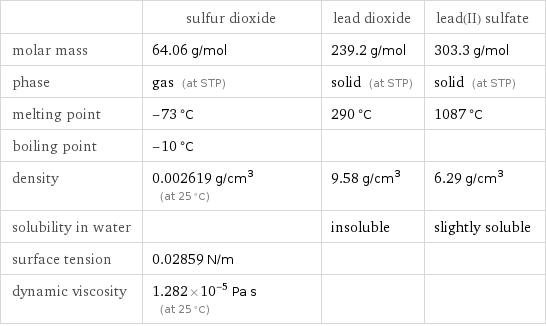
| sulfur dioxide | lead dioxide | lead(II) sulfate molar mass | 64.06 g/mol | 239.2 g/mol | 303.3 g/mol phase | gas (at STP) | solid (at STP) | solid (at STP) melting point | -73 °C | 290 °C | 1087 °C boiling point | -10 °C | | density | 0.002619 g/cm^3 (at 25 °C) | 9.58 g/cm^3 | 6.29 g/cm^3 solubility in water | | insoluble | slightly soluble surface tension | 0.02859 N/m | | dynamic viscosity | 1.282×10^-5 Pa s (at 25 °C) | |
Units

Input interpretation

SO_2 sulfur dioxide + PBO2 ⟶ PBSO4
Balanced equation

Balance the chemical equation algebraically: SO_2 + PBO2 ⟶ PBSO4 Add stoichiometric coefficients, c_i, to the reactants and products: c_1 SO_2 + c_2 PBO2 ⟶ c_3 PBSO4 Set the number of atoms in the reactants equal to the number of atoms in the products for O, S, P and B: O: | 2 c_1 + 2 c_2 = 4 c_3 S: | c_1 = c_3 P: | c_2 = c_3 B: | c_2 = c_3 Since the coefficients are relative quantities and underdetermined, choose a coefficient to set arbitrarily. To keep the coefficients small, the arbitrary value is ordinarily one. For instance, set c_1 = 1 and solve the system of equations for the remaining coefficients: c_1 = 1 c_2 = 1 c_3 = 1 Substitute the coefficients into the chemical reaction to obtain the balanced equation: Answer: | | SO_2 + PBO2 ⟶ PBSO4
Structures

+ PBO2 ⟶ PBSO4
Names

sulfur dioxide + PBO2 ⟶ PBSO4
Equilibrium constant
![Construct the equilibrium constant, K, expression for: SO_2 + PBO2 ⟶ PBSO4 Plan: • Balance the chemical equation. • Determine the stoichiometric numbers. • Assemble the activity expression for each chemical species. • Use the activity expressions to build the equilibrium constant expression. Write the balanced chemical equation: SO_2 + PBO2 ⟶ PBSO4 Assign stoichiometric numbers, ν_i, using the stoichiometric coefficients, c_i, from the balanced chemical equation in the following manner: ν_i = -c_i for reactants and ν_i = c_i for products: chemical species | c_i | ν_i SO_2 | 1 | -1 PBO2 | 1 | -1 PBSO4 | 1 | 1 Assemble the activity expressions accounting for the state of matter and ν_i: chemical species | c_i | ν_i | activity expression SO_2 | 1 | -1 | ([SO2])^(-1) PBO2 | 1 | -1 | ([PBO2])^(-1) PBSO4 | 1 | 1 | [PBSO4] The equilibrium constant symbol in the concentration basis is: K_c Mulitply the activity expressions to arrive at the K_c expression: Answer: | | K_c = ([SO2])^(-1) ([PBO2])^(-1) [PBSO4] = ([PBSO4])/([SO2] [PBO2])](../image_source/39e843fdd37a6275efcb25f9f11b15f3.png)
Construct the equilibrium constant, K, expression for: SO_2 + PBO2 ⟶ PBSO4 Plan: • Balance the chemical equation. • Determine the stoichiometric numbers. • Assemble the activity expression for each chemical species. • Use the activity expressions to build the equilibrium constant expression. Write the balanced chemical equation: SO_2 + PBO2 ⟶ PBSO4 Assign stoichiometric numbers, ν_i, using the stoichiometric coefficients, c_i, from the balanced chemical equation in the following manner: ν_i = -c_i for reactants and ν_i = c_i for products: chemical species | c_i | ν_i SO_2 | 1 | -1 PBO2 | 1 | -1 PBSO4 | 1 | 1 Assemble the activity expressions accounting for the state of matter and ν_i: chemical species | c_i | ν_i | activity expression SO_2 | 1 | -1 | ([SO2])^(-1) PBO2 | 1 | -1 | ([PBO2])^(-1) PBSO4 | 1 | 1 | [PBSO4] The equilibrium constant symbol in the concentration basis is: K_c Mulitply the activity expressions to arrive at the K_c expression: Answer: | | K_c = ([SO2])^(-1) ([PBO2])^(-1) [PBSO4] = ([PBSO4])/([SO2] [PBO2])
Rate of reaction
![Construct the rate of reaction expression for: SO_2 + PBO2 ⟶ PBSO4 Plan: • Balance the chemical equation. • Determine the stoichiometric numbers. • Assemble the rate term for each chemical species. • Write the rate of reaction expression. Write the balanced chemical equation: SO_2 + PBO2 ⟶ PBSO4 Assign stoichiometric numbers, ν_i, using the stoichiometric coefficients, c_i, from the balanced chemical equation in the following manner: ν_i = -c_i for reactants and ν_i = c_i for products: chemical species | c_i | ν_i SO_2 | 1 | -1 PBO2 | 1 | -1 PBSO4 | 1 | 1 The rate term for each chemical species, B_i, is 1/ν_i(Δ[B_i])/(Δt) where [B_i] is the amount concentration and t is time: chemical species | c_i | ν_i | rate term SO_2 | 1 | -1 | -(Δ[SO2])/(Δt) PBO2 | 1 | -1 | -(Δ[PBO2])/(Δt) PBSO4 | 1 | 1 | (Δ[PBSO4])/(Δt) (for infinitesimal rate of change, replace Δ with d) Set the rate terms equal to each other to arrive at the rate expression: Answer: | | rate = -(Δ[SO2])/(Δt) = -(Δ[PBO2])/(Δt) = (Δ[PBSO4])/(Δt) (assuming constant volume and no accumulation of intermediates or side products)](../image_source/8f23f3f1d8773c9051f8dba6b62be805.png)
Construct the rate of reaction expression for: SO_2 + PBO2 ⟶ PBSO4 Plan: • Balance the chemical equation. • Determine the stoichiometric numbers. • Assemble the rate term for each chemical species. • Write the rate of reaction expression. Write the balanced chemical equation: SO_2 + PBO2 ⟶ PBSO4 Assign stoichiometric numbers, ν_i, using the stoichiometric coefficients, c_i, from the balanced chemical equation in the following manner: ν_i = -c_i for reactants and ν_i = c_i for products: chemical species | c_i | ν_i SO_2 | 1 | -1 PBO2 | 1 | -1 PBSO4 | 1 | 1 The rate term for each chemical species, B_i, is 1/ν_i(Δ[B_i])/(Δt) where [B_i] is the amount concentration and t is time: chemical species | c_i | ν_i | rate term SO_2 | 1 | -1 | -(Δ[SO2])/(Δt) PBO2 | 1 | -1 | -(Δ[PBO2])/(Δt) PBSO4 | 1 | 1 | (Δ[PBSO4])/(Δt) (for infinitesimal rate of change, replace Δ with d) Set the rate terms equal to each other to arrive at the rate expression: Answer: | | rate = -(Δ[SO2])/(Δt) = -(Δ[PBO2])/(Δt) = (Δ[PBSO4])/(Δt) (assuming constant volume and no accumulation of intermediates or side products)
Chemical names and formulas
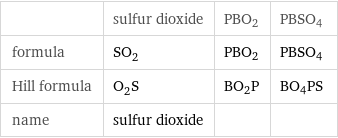
| sulfur dioxide | PBO2 | PBSO4 formula | SO_2 | PBO2 | PBSO4 Hill formula | O_2S | BO2P | BO4PS name | sulfur dioxide | |
Substance properties
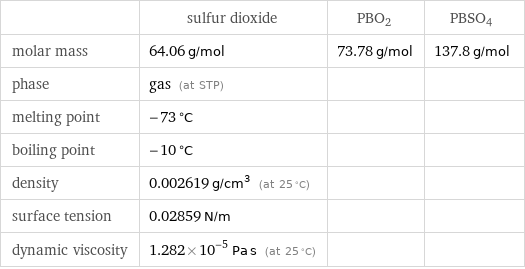
| sulfur dioxide | PBO2 | PBSO4 molar mass | 64.06 g/mol | 73.78 g/mol | 137.8 g/mol phase | gas (at STP) | | melting point | -73 °C | | boiling point | -10 °C | | density | 0.002619 g/cm^3 (at 25 °C) | | surface tension | 0.02859 N/m | | dynamic viscosity | 1.282×10^-5 Pa s (at 25 °C) | |
Units

Input interpretation

SO_2 sulfur dioxide + PBO2 ⟶ PBSO4
Balanced equation
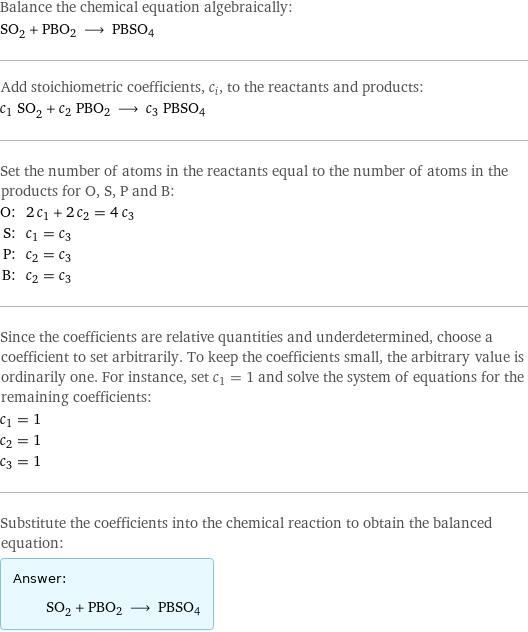
Balance the chemical equation algebraically: SO_2 + PBO2 ⟶ PBSO4 Add stoichiometric coefficients, c_i, to the reactants and products: c_1 SO_2 + c_2 PBO2 ⟶ c_3 PBSO4 Set the number of atoms in the reactants equal to the number of atoms in the products for O, S, P and B: O: | 2 c_1 + 2 c_2 = 4 c_3 S: | c_1 = c_3 P: | c_2 = c_3 B: | c_2 = c_3 Since the coefficients are relative quantities and underdetermined, choose a coefficient to set arbitrarily. To keep the coefficients small, the arbitrary value is ordinarily one. For instance, set c_1 = 1 and solve the system of equations for the remaining coefficients: c_1 = 1 c_2 = 1 c_3 = 1 Substitute the coefficients into the chemical reaction to obtain the balanced equation: Answer: | | SO_2 + PBO2 ⟶ PBSO4
Structures

+ PBO2 ⟶ PBSO4
Names

sulfur dioxide + PBO2 ⟶ PBSO4
Equilibrium constant
![Construct the equilibrium constant, K, expression for: SO_2 + PBO2 ⟶ PBSO4 Plan: • Balance the chemical equation. • Determine the stoichiometric numbers. • Assemble the activity expression for each chemical species. • Use the activity expressions to build the equilibrium constant expression. Write the balanced chemical equation: SO_2 + PBO2 ⟶ PBSO4 Assign stoichiometric numbers, ν_i, using the stoichiometric coefficients, c_i, from the balanced chemical equation in the following manner: ν_i = -c_i for reactants and ν_i = c_i for products: chemical species | c_i | ν_i SO_2 | 1 | -1 PBO2 | 1 | -1 PBSO4 | 1 | 1 Assemble the activity expressions accounting for the state of matter and ν_i: chemical species | c_i | ν_i | activity expression SO_2 | 1 | -1 | ([SO2])^(-1) PBO2 | 1 | -1 | ([PBO2])^(-1) PBSO4 | 1 | 1 | [PBSO4] The equilibrium constant symbol in the concentration basis is: K_c Mulitply the activity expressions to arrive at the K_c expression: Answer: | | K_c = ([SO2])^(-1) ([PBO2])^(-1) [PBSO4] = ([PBSO4])/([SO2] [PBO2])](../image_source/ed1429fd1f4c459b2c67a0c166754f7c.png)
Construct the equilibrium constant, K, expression for: SO_2 + PBO2 ⟶ PBSO4 Plan: • Balance the chemical equation. • Determine the stoichiometric numbers. • Assemble the activity expression for each chemical species. • Use the activity expressions to build the equilibrium constant expression. Write the balanced chemical equation: SO_2 + PBO2 ⟶ PBSO4 Assign stoichiometric numbers, ν_i, using the stoichiometric coefficients, c_i, from the balanced chemical equation in the following manner: ν_i = -c_i for reactants and ν_i = c_i for products: chemical species | c_i | ν_i SO_2 | 1 | -1 PBO2 | 1 | -1 PBSO4 | 1 | 1 Assemble the activity expressions accounting for the state of matter and ν_i: chemical species | c_i | ν_i | activity expression SO_2 | 1 | -1 | ([SO2])^(-1) PBO2 | 1 | -1 | ([PBO2])^(-1) PBSO4 | 1 | 1 | [PBSO4] The equilibrium constant symbol in the concentration basis is: K_c Mulitply the activity expressions to arrive at the K_c expression: Answer: | | K_c = ([SO2])^(-1) ([PBO2])^(-1) [PBSO4] = ([PBSO4])/([SO2] [PBO2])
Rate of reaction
![Construct the rate of reaction expression for: SO_2 + PBO2 ⟶ PBSO4 Plan: • Balance the chemical equation. • Determine the stoichiometric numbers. • Assemble the rate term for each chemical species. • Write the rate of reaction expression. Write the balanced chemical equation: SO_2 + PBO2 ⟶ PBSO4 Assign stoichiometric numbers, ν_i, using the stoichiometric coefficients, c_i, from the balanced chemical equation in the following manner: ν_i = -c_i for reactants and ν_i = c_i for products: chemical species | c_i | ν_i SO_2 | 1 | -1 PBO2 | 1 | -1 PBSO4 | 1 | 1 The rate term for each chemical species, B_i, is 1/ν_i(Δ[B_i])/(Δt) where [B_i] is the amount concentration and t is time: chemical species | c_i | ν_i | rate term SO_2 | 1 | -1 | -(Δ[SO2])/(Δt) PBO2 | 1 | -1 | -(Δ[PBO2])/(Δt) PBSO4 | 1 | 1 | (Δ[PBSO4])/(Δt) (for infinitesimal rate of change, replace Δ with d) Set the rate terms equal to each other to arrive at the rate expression: Answer: | | rate = -(Δ[SO2])/(Δt) = -(Δ[PBO2])/(Δt) = (Δ[PBSO4])/(Δt) (assuming constant volume and no accumulation of intermediates or side products)](../image_source/e6efde4547300e690aaf3a5b8195d510.png)
Construct the rate of reaction expression for: SO_2 + PBO2 ⟶ PBSO4 Plan: • Balance the chemical equation. • Determine the stoichiometric numbers. • Assemble the rate term for each chemical species. • Write the rate of reaction expression. Write the balanced chemical equation: SO_2 + PBO2 ⟶ PBSO4 Assign stoichiometric numbers, ν_i, using the stoichiometric coefficients, c_i, from the balanced chemical equation in the following manner: ν_i = -c_i for reactants and ν_i = c_i for products: chemical species | c_i | ν_i SO_2 | 1 | -1 PBO2 | 1 | -1 PBSO4 | 1 | 1 The rate term for each chemical species, B_i, is 1/ν_i(Δ[B_i])/(Δt) where [B_i] is the amount concentration and t is time: chemical species | c_i | ν_i | rate term SO_2 | 1 | -1 | -(Δ[SO2])/(Δt) PBO2 | 1 | -1 | -(Δ[PBO2])/(Δt) PBSO4 | 1 | 1 | (Δ[PBSO4])/(Δt) (for infinitesimal rate of change, replace Δ with d) Set the rate terms equal to each other to arrive at the rate expression: Answer: | | rate = -(Δ[SO2])/(Δt) = -(Δ[PBO2])/(Δt) = (Δ[PBSO4])/(Δt) (assuming constant volume and no accumulation of intermediates or side products)
Chemical names and formulas
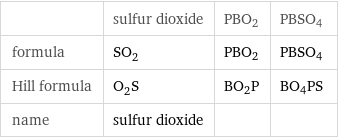
| sulfur dioxide | PBO2 | PBSO4 formula | SO_2 | PBO2 | PBSO4 Hill formula | O_2S | BO2P | BO4PS name | sulfur dioxide | |
Substance properties
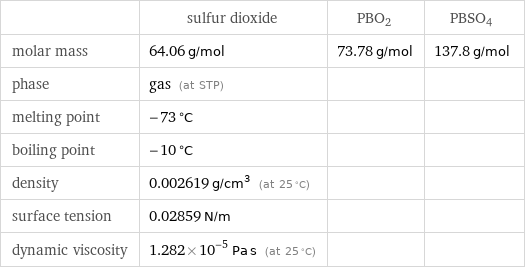
| sulfur dioxide | PBO2 | PBSO4 molar mass | 64.06 g/mol | 73.78 g/mol | 137.8 g/mol phase | gas (at STP) | | melting point | -73 °C | | boiling point | -10 °C | | density | 0.002619 g/cm^3 (at 25 °C) | | surface tension | 0.02859 N/m | | dynamic viscosity | 1.282×10^-5 Pa s (at 25 °C) | |
Units
